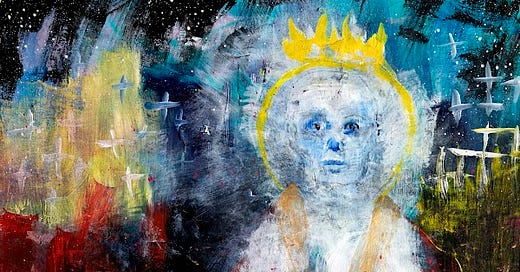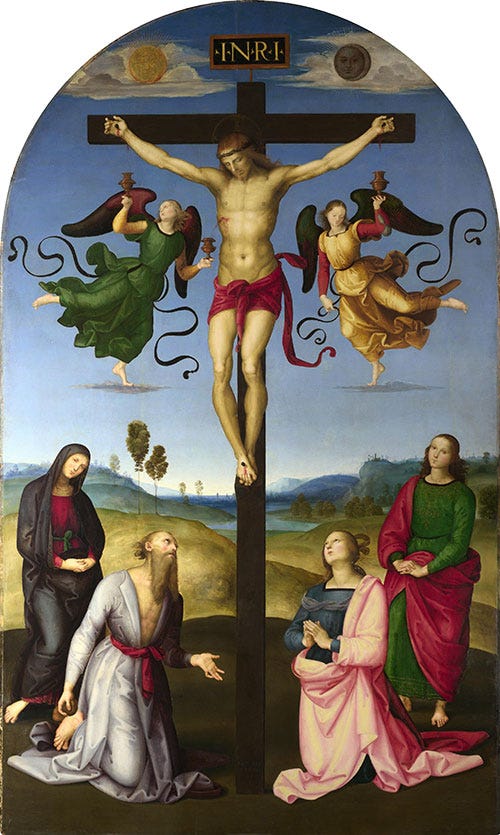The Apocalypse Amongst Us
"Let there be light, and it was so" was the first meme and the artwork of Apocalypse Art shows us the way
I bet I know the first time you saw the word Apocalypse. You were watching a news show on TV or you saw a news headline and you saw references to a wildfire or a bomb explosion or the incineration of a village and the media sayeth: “Apocalyptic!”.
Being the good semiotic student you are, you, like me, probably assumed the media knew what they were talking about and that “apocalypse” and its derivatives meant utter and end of the world destruction. Indeed, there is a modern definition of apocalypse that states this is true.
But the origin of the English word apocalypse is actually similar to the first memes of Genesis, book 1, as written in the King James Bible:
The word apocalyptic doesn’t actually mean the destruction of the world. Its origin root is Greek and it means “to uncover.”
The idea of meaning and visual senses combining together to reveal a truth that has a transformative experience on us through art first came to Apocalypse Art when he was 21 years old visiting the National Gallery in London.
He saw Raphael’s Mond Crucifixion.
“The Christ is on the cross but floating; the blood is pouring but there is no trace of violence. The angels, the people, the sun and moon — it is as if the whole thing is a divine puzzle, beautifully put together and full of meaning, but hard to decipher. And then I heard the figure under the cross speaking — grumbling sort of, or lamenting. Not with my ears, you understand — but inwardly. This was a very strange and vivid experience. I looked away, it stopped; I look again, and the speaking began again.”
In his work, many of the pieces have figures like this “grumbling” one at the foot of the Christ, but they seem to be central figures, grounded, or close to the foreground, but also featured prominently.
It may be a bit of a leap, but these half-emerged figures seem to be the embodiment of the speaking figure, not the Christ itself, but a witness to Him.
Sometimes they even seem far away, in the midst of the landscape, as if the artist is trying to figure out just what to let emerge, when and where.
It’s an interesting mindtwist, because you can imagine the artist dreaming him up, and intentionally placing him there, a bit at a distance, asking or waiting for permission to encounter.
But there is one digital work he has done that is really striking for how it blends together the colour matching of the Mond Crucifixion (though a little brighter) and the dreamy, revelatory floating of his first experience.
It’s “Redemption,” which is part of a series he calls “The Meeings”.
Here are two witnesses to the Christ figure painted like skeletons, and in their hypermodern colours it seems clear that these are not created out of an atavistic view of life (not looking back), but as if something has been brought forward.
The skeleton represents an avatar, from the Sanskrit, avatara, or stepping down to cross over. Apocalypse Art tells me:
I started drawing skeletons many years ago when I was teaching myself to draw. I found that the skeleton conveyed a human being, but a part of us that is invisible.
The skeleton is often associated with death, because if you see someone’s skeleton, that person is dead. But when a skeleton is standing or running or praying, and then it’s closer to a ghost or a spirit. So it is two things: the physical part of us that survives death, but also a representation of the spiritual part of us that survives death.
Here, the skeletons are a pair, and they are in side profile.
“When I represent a skeleton, I am calling on the viewer’s innate knowledge, perhaps mostly forgotten, that they too are not only a physical being but also an inner being. Sufficient experience of this “inwardness” can open all kinds of doors.”
Emerging between the pair is a beam of light, the kind of holy and piercing stimulus you see in a Loie Hollowell painting, where you forget the physics of light and receive it as a guttural and sensual stimulation.
It very much looks as if a portal has opened, but interestingly there is no figure or representation that indicates an aperture. One can believe that one exists, though.
Something otherworldly but also intimately human emerges during this cast of light. You can see it in many other paintings. Spirit-hood.
There is definitely a spiritual quality to my work. Not a spiritual as in woo-woo new age, but spiritual as in a larger frame of reference for humanity and life. Francis Bacon’s work is spiritual too, for example, even though his work focuses mostly on the “isolation, horror, and loneliness” spectrum of spiritual reality. My work attempts to span a larger spectrum, including all the heavens and hells that humans experience in their ages long journey.
It’s a mythology if you will, but of course, myths are true from certain points of view.
His current work falls into this and three other series, some of which have not been completed or even minted yet: On opensea are the Meeings, the Editions, and a collection of Sketches, Derivatives, and Collaborations. There will be a few more series art, soon. They all travel through this mythological exploration.
They all seem to be painted with deep appreciation for their ability to illuminate the thinking of the artist and his emotional work with the digital canvas, but also they seem to present themselves well as works of gratitude given to the audience.
One can’t help but think in the presence of such work that art is unapologetically good to us.
But we seem to never ask why. Is it because the answer we will receive will stun us, the way a young man of 21 was stunned in the National Gallery of London when he first saw, not real blood, but the blood of an artist, illuminated in oil?
He was forever changed. Are we afraid of being changed? Or, is it that we just don’t know we can be changed, deserved to be changed? Not in a “come to Christ” moment, but in a “come to seeing” moment.
We are back with Apocalypse Art when he was in the National Gallery looking at Raphael’s work hung on poplar wood:
“At this moment, I thought, I want my art to speak like this. I can almost hear this painting!” he says.
“So I’m plodding along doing my best to get there. Some people have lately told me they could feel the wind in the work, and things like that. So maybe we’re getting somewhere,” he says.
By the way, in Redemption, the door is the two figures, standing apart, to let the light in between them.
Now look. Again. Closer. In Raphael’s Mond Crucifixion, the painting is the door to consciousness. This is true for every work of art.
Open the door.








